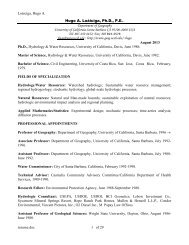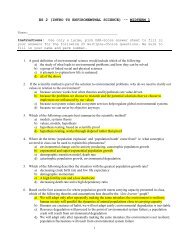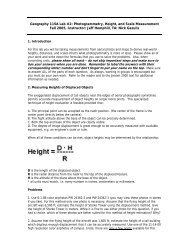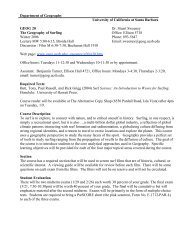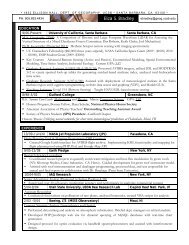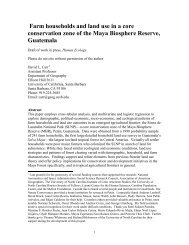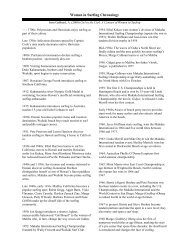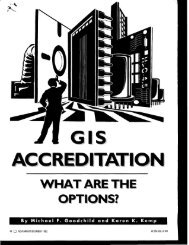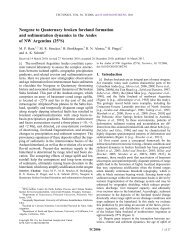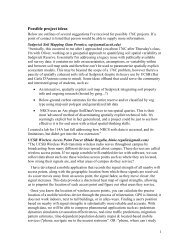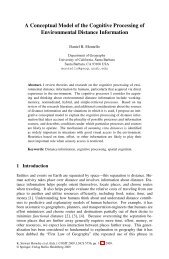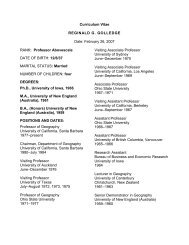Spatial knowledge acquisition from direct experience in the ...
Spatial knowledge acquisition from direct experience in the ...
Spatial knowledge acquisition from direct experience in the ...
You also want an ePaper? Increase the reach of your titles
YUMPU automatically turns print PDFs into web optimized ePapers that Google loves.
122 T. Ishikawa, D.R. Montello / Cognitive Psychology 52 (2006) 93–129<br />
of <strong>the</strong> metrically scaled, two-dimensional layout of landmarks and routes). 8 Although<br />
Siegel and White do not specify a time frame for this progression, it is apparently<br />
<strong>in</strong>tended to be on <strong>the</strong> order of months or years. Our results clearly argue aga<strong>in</strong>st this<br />
framework. In particular, some of our participants acquired route and even survey<br />
<strong>knowledge</strong> after <strong>the</strong> Wrst session of exposure to <strong>the</strong> test environments; <strong>in</strong> <strong>the</strong> case of at<br />
least a couple participants, this early survey <strong>knowledge</strong> was even quite precise. Conversely,<br />
o<strong>the</strong>r participants never acquired particularly good survey <strong>knowledge</strong>, even<br />
after 10 sessions over more than two months of time, total<strong>in</strong>g some 12 or more hours of<br />
exposure. It appears that <strong>the</strong> developmental progression <strong>from</strong> route to survey <strong>knowledge</strong><br />
proposed by Siegel and White, and promoted by many o<strong>the</strong>r researchers, is not a progression<br />
after all. We Wnd <strong>in</strong>stead that <strong>the</strong> dist<strong>in</strong>ction between route and survey <strong>knowledge</strong><br />
is more correctly characterized as an <strong>in</strong>dividual diVerence trait, as evidenced by <strong>the</strong><br />
large diVerences <strong>in</strong> <strong>the</strong> accuracy of conWgurational understand<strong>in</strong>g of <strong>the</strong> routes and <strong>the</strong><br />
generally stable performance across sessions.<br />
Montello’s (1998) cont<strong>in</strong>uous framework accounts better for our results, but it falls<br />
short to some extent too. The cont<strong>in</strong>uous framework is apparently correct <strong>in</strong> posit<strong>in</strong>g<br />
that metric <strong>knowledge</strong> of layout beg<strong>in</strong>s to be acquired more or less immediately, upon<br />
Wrst exposure to a new place. However, this occurs only for some <strong>in</strong>dividuals. O<strong>the</strong>r <strong>in</strong>dividuals<br />
do not acquire survey <strong>knowledge</strong> early; <strong>in</strong> fact, <strong>the</strong>y may never achieve such an<br />
understand<strong>in</strong>g of environmental layout. So even though <strong>the</strong> cont<strong>in</strong>uous framework<br />
stresses <strong>the</strong> importance of large <strong>in</strong>dividual variations, it still does not do full justice to<br />
<strong>the</strong> signiWcant qualitative as well as quantitative nature of <strong>the</strong>se variations. The cont<strong>in</strong>uous<br />
framework appears to be a developmental <strong>the</strong>ory for people with a good sense-of<strong>direct</strong>ion.<br />
Just as some people can grasp <strong>the</strong> layout of a s<strong>in</strong>gle curved route (like our U-route)<br />
quite quickly, and o<strong>the</strong>rs cannot, some people can apparently grasp <strong>the</strong> <strong>in</strong>tegrated relationship<br />
of separately learned routes fairly quickly when <strong>the</strong>y are given adequate <strong>in</strong>formation<br />
about <strong>the</strong> relationships of <strong>the</strong> routes. But even our best perform<strong>in</strong>g participants<br />
found this task somewhat more diYcult than grasp<strong>in</strong>g <strong>the</strong> layout of a s<strong>in</strong>gle route. We<br />
Wnd this to be consistent with <strong>the</strong> idea, found <strong>in</strong> both <strong>the</strong> dom<strong>in</strong>ant and cont<strong>in</strong>uous<br />
frameworks, that <strong>the</strong> <strong>in</strong>tegration of separately learned places and routes is a diYcult but<br />
possible achievement <strong>in</strong> <strong>the</strong> microgenesis of environmental <strong>knowledge</strong>. However, our<br />
data do not tell us whe<strong>the</strong>r this <strong>in</strong>tegrated <strong>knowledge</strong> exists as a stored <strong>in</strong>ternal representation<br />
of <strong>the</strong> two routes comb<strong>in</strong>ed <strong>in</strong>to a s<strong>in</strong>gle representation (an “<strong>in</strong>tegrated cognitive<br />
map”) or as two representations that rema<strong>in</strong> essentially separate but can be <strong>in</strong>tegrated <strong>in</strong><br />
work<strong>in</strong>g memory when a between-route task requires it. That is, we cannot tell whe<strong>the</strong>r<br />
between-route tasks depend on a stored representation of <strong>the</strong> two routes or an <strong>in</strong>ference<br />
process that occurs at <strong>the</strong> time of task adm<strong>in</strong>istration (this issue is discussed at length by<br />
Montello, Waller, Hegarty, & Richardson, 2004).<br />
8 As we discussed <strong>in</strong> Section 1, important characteristics of large-scale environments that are dealt with by Siegel<br />
and White (and o<strong>the</strong>r researchers, <strong>in</strong>clud<strong>in</strong>g Ittelson) are that a person cannot see <strong>the</strong> layout of <strong>the</strong> space <strong>in</strong> its<br />
entirety <strong>from</strong> a s<strong>in</strong>gle viewpo<strong>in</strong>t, and that <strong>the</strong> person can <strong>experience</strong> <strong>the</strong> space by mov<strong>in</strong>g through it, not necessarily<br />
that <strong>the</strong>re are multiple routes and landmarks <strong>in</strong> <strong>the</strong> space. So, although <strong>the</strong> two routes selected <strong>in</strong> our study<br />
constitute a subset of <strong>the</strong> study area, we believe that it is a legitimate realization of <strong>the</strong> environment as described<br />
by <strong>the</strong> Siegel and White framework. If <strong>the</strong> space gets much larger, spatial <strong>knowledge</strong> is usually acquired <strong>from</strong><br />
<strong>in</strong><strong>direct</strong> sources, such as maps.



